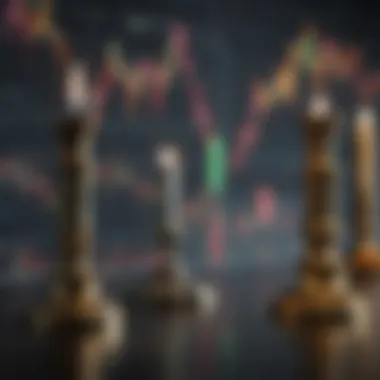Mastering Candlestick Patterns for Day Trading


Intro
Day trading, a fast-paced and often thrilling endeavor, hinges on the ability to predict short-term price movements. One of the most useful tools for traders is the candlestick chart, which provides a visual representation of price action over a given timeframe. Understanding how to read these candles effectively can greatly enhance a trader's ability to make informed decisions. In this guide, we'll delve deep into the world of candlestick patterns, exploring their significance and the psychological factors that influence market movements.
As investors and traders immerse themselves in this subject, they'll find that candlesticks not only reveal past price behavior but also offer insights into future market shifts. By grasping the nuances of these patterns, traders can hone their strategies and navigate the intricate landscape of day trading with a sharper edge.
Cryptocurrency Fundamentals
Though candlestick analysis might not be exclusive to cryptocurrencies, it's crucial to understand the underlying assets and their market frameworks.
Understanding Blockchain Technology
Blockchain technology serves as the backbone of cryptocurrencies. It’s a decentralized ledger that records all transactions across a network, ensuring transparency and security. Each block in this chain contains a list of transactions, and once added, it’s nearly impossible to change—surely a feature that keeps traders on their toes. The decentralized nature eliminates the need for intermediaries, thus driving down transaction costs, and providing traders with direct access to the market.
Key Concepts in Cryptocurrency Trading
In the cryptocurrency realm, certain terminology and concepts recur. Traders familiar with these can analyze candlestick patterns more effectively. Here are some core concepts:
- Market Capitalization: Reflects the total market value of a cryptocurrency. It helps gauge the level of adoption and liquidity.
- Volatility: Cryptocurrencies are known for their wild price swings, which can create substantial opportunities—and risks—for day traders.
- Supports and Resistances: These levels indicate the price points at which cryptocurrencies tend to stall or change direction, pivotal for accurate trading decisions.
"Understanding market sentiment through candlestick patterns can make the difference between profit and loss."
Adopting a thorough knowledge of these fundamental concepts not only aids traders in reading candlestick formations but enriches their overall trading perspective.
Market Insights
With the foundation laid, it's time to shift our focus towards the real-time environment in which these candlestick patterns occur.
Current Trends in the Crypto Market
The cryptocurrency market is ever-changing, with trends emerging unexpectedly and rapidly. Currently, the resurgence of interest in altcoins has traders buzzing. Traditional safe havens, such as Bitcoin and Ethereum, still dominate but lookout for emerging tokens that may warrant attention. Keeping an eye on these shifts can be crucial for timing trades effectively.
Analyzing Market Movements and Predictions
Traders who commit themselves to a fastidious analysis of market behaviors and candlestick formations often succeed beyond their counterparts. Utilizing tools such as moving averages and the Relative Strength Index can complement candlestick readings. Determining where the market is heading relies on blending these insights with personal strategy, and—at times—active intuition based on market familiarity.
By consistently honing one's understanding of candlestick patterns and staying attuned to cryptocurrency market trends, traders can navigate through complexities with more confidence. The interplay of understanding price action, being aware of psychological factors, and decisive action can empower traders toward achieving their financial goals.
Understanding Candlestick Basics
When navigating the choppy waters of day trading, grasping the fundamentals of candlestick patterns is crucial. These colorful little bars on a chart tell a story—a snapshot of market dynamics at a glance. Understanding candlestick basics empowers traders to make informed decisions based on price movements and market psychology.
Candlesticks not only represent changes in price but also convey trader sentiment. When you can read these patterns accurately, you gain valuable insights into the market's behavior, which is critical for developing effective trading strategies. Furthermore, recognizing different patterns allows traders to anticipate potential price movements, enabling them to enter or exit trades with a bigger chance of success.
In this section, we will delve into what candlesticks are, their key components, and the importance of different time frames. A solid foundation will not only boost your understanding but also enhance your trading confidence and decision-making skills.
What is a Candlestick?
A candlestick is a graphical representation of price movements within a specified time frame. Each candlestick contains key information: open, close, high, and low prices. When placed together, candlesticks form patterns, and these patterns reveal trends and potential reversal points in the market.
Understanding what each candlestick signifies is essential. For instance, a candlestick with a long body suggests strong price movement in one direction, while a smaller one might indicate indecision. The colors of the candlestick—typically red for a close below the open and green for a close above—also provide immediate visual cues about market sentiment.
Components of a Candlestick
Open Price
The open price is the first price at which a trade occurs during a specified time frame. It’s an essential indicator as it sets the stage for the trading session. A candlestick that opens higher than the previous close may suggest bullish sentiment, while a lower open could indicate bearishness.
With open prices, you can assess market direction at the start of a trading period. Recognizing the open price helps you gauge momentum in the market. Traders often consider it beneficial as it provides a reference point against which to compare subsequent price movements.
However, focusing solely on the open price without considering other components is a pitfall. It’s not a standalone indicator and should be viewed in conjunction with the close, high, and low prices for a complete picture.
Close Price
The close price is the final price recorded at the end of the candlestick’s time frame. It’s often regarded as one of the most significant components of a candlestick as it reflects the market sentiment at that moment.
Traders typically see the close price as a conclusive signal because it shows where the market participants decided to agree on a price at the end of that period. Thus, utilizing the close price can provide insights into trends. A candlestick that closes higher than it opened demonstrates bullishness and potential upward momentum.
But be cautious; overemphasizing the close price can lead to missed opportunities. Market conditions can change rapidly, so using the close together with other indicators provides a more robust analysis.
High Price
The high price indicates the highest point a security reaches during the candlestick's time frame. This measure is crucial for identifying trading opportunities and understanding market volatility.
High prices can provide insights into the strength of a trend. A series of increasing highs may signal a robust bullish trend, whereas consistent lower highs can hint at bearishness. Thus, recognizing these highs becomes indispensable for crafting strategies around entry and exit points.
Nonetheless, relying solely on high prices without context can be misleading. It’s important to contextualize high prices within the pattern's broader narrative.
Low Price
Conversely, the low price is the lowest point reached during the time frame. This value showcases potential support levels, allowing traders to identify where prices might bounce back.
Recognizing a low price's significance can also help in risk management. If a stock hits a low and consistently bounces back, it may signal a support point that traders can leverage. This aspect makes the low price particularly beneficial in managing trades effectively.
However, just like the high price, understanding low prices in isolation can lead to flawed conclusions. It's pivotal to view them in conjunction with high prices and other candlesticks to form a comprehensive market outlook.
Time Frames for Candlestick Charts


When analyzing candlesticks, the time frame you choose can dramatically influence your trading decisions. Different time frames provide various perspectives on market movements.
Intraday Candlestick Patterns
Intraday candlestick patterns are formed within specific trading sessions, like a single day or even shorter intervals like minutes. Traders often utilize these patterns for day trading, as they offer more immediate insights into price movements and market behavior.
These patterns allow traders to capitalize on small price shifts throughout the day. Spotting strong intraday candlestick formations can be the difference between a profitable trade and a hefty loss. The fast-paced nature of intraday trading requires keeping an eye on these patterns closely, as they can rapidly change.
One might view the advantage of intraday patterns as their speed; however, the risk is higher due to quick price fluctuations. Those who engage in this kind of trading should be prepared for rapid decision-making and the inherent volatility.
Daily and Weekly Patterns
Daily and weekly candlestick patterns provide a broader market perspective over extended periods. Such patterns allow traders to spot longer-term trends and reinforce their strategies with more reliable data.
Daily and weekly patterns can help you avoid false signals that might occur over shorter periods. They often indicate general market sentiment and are helpful for confirming the bullish or bearish trends spotted in intraday analysis.
However, the downside is that these patterns may be slow to react, leading to missed opportunities in rapidly changing market conditions. Traders must balance the need for detailed analyses while remaining responsive to current events that may impact prices.
The Psychology Behind Candlesticks
Understanding the psychology behind candlesticks is crucial for any trader looking to make informed decisions in the fast-paced world of day trading. It’s not just about numbers and charts; it’s about grasping the underlying emotions and sentiments that drive the market. By delving into this psychological terrain, traders can gain a deeper understanding of market movements, improving their ability to interpret signals and patterns.
Understanding Market Sentiment
Market sentiment is like the heartbeat of trading; it reflects how traders feel about the market's direction. This sentiment is largely influenced by external factors—news releases, economic reports, and global events—all of which can sway traders’ emotions on a dime. Traders often react emotionally to these stimuli, making decisions that can either align or clash with technical indicators.
For example, during major economic announcements, traders might look at candlestick movements to predict short-term price changes. A large green candlestick after a positive jobs report might indicate bullish sentiment, driving more purchases. Conversely, a series of red candlesticks may signal growing bearish sentiment, prompting traders to sell off their positions. Recognizing these sentiments allows traders to foresee potential market reversals or continuations.
Bullish vs Bearish Sentiment
When discussing sentiment, differentiation between bullish and bearish is paramount. Bullish sentiment implies a general feeling of confidence among traders, fostering optimism that prices will rise. This is often illustrated through candlestick patterns like hammer or morning star, which signal potential upside opportunities. Traders might feel empowered to buy, believing that the upward trend is just beginning.
On the flip side, bearish sentiment signifies a lack of confidence, with traders anticipating a decline in asset prices. Patterns like shooting star or evening star provide visual cues of this sentiment. When such patterns form, traders may rush to sell, fearing that the downtrend will intensify. The psychological battle between bullish and bearish traders plays out through candlestick formations, making it essential to interpret these patterns in the context of sentiment.
Role of Emotion in Trading
Emotion is a double-edged sword in trading—while it can drive traders to act, it can also lead them astray. Fear and greed are the two juggernauts of emotion that can heavily influence trading decisions. For example, during a rapid price increase, greed can push traders to hold onto their positions, even when indicators might suggest it’s time to sell. This often results in panic selling when prices eventually tumble, as fear outweighs previous optimism.
Candlestick patterns can help mitigate emotional decision-making by providing objective data points. Recognizing when a doji occurs, for instance, can signal indecision in the market, prompting traders to reevaluate their positions rather than hastily respond to fear or greed. By integrating understanding of these emotions with the signals from candlestick patterns, traders develop a more grounded approach to trading.
*“Understanding the psychological factors that drive market movement can give traders a significant edge in navigating trades.
Key Candlestick Patterns for Day Trading
Understanding key candlestick patterns is crucial for day traders looking to gain an edge in their strategies. These patterns serve as indicators, offering insights into potential price movements and market sentiment. Recognition of these formations can assist traders in making timely decisions, thereby enhancing their trading effectiveness.
Both single and multiple candlestick patterns are essential to employ in day trading. Recognizing these patterns facilitates the interpretation of market sentiment, significantly impacting potential entry or exit points in trades. Among traders, specific patterns have earned reputational acclaim due to their reliability in predicting market trends. In the following sections, we take a closer look at some of the most prominent single and multiple candlestick patterns.
Single Candlestick Patterns
Doji
The Doji is a notable candlestick pattern characterized by a very small body, which indicates indecision in the market. It occurs when the opening and closing prices are nearly equal, resulting in an almost horizontal appearance. This pattern suggests that neither buyers nor sellers have gained control, leading to uncertainty about the next direction.
The inherent value of the Doji lies in its ability to signal potential reversals or continuation in the market. A Doji following a strong upward or downward trend may imply a shift in sentiment, making it a beneficial pattern to watch for day traders. One unique feature of the Doji is that it can take several forms, such as the Long-Legged Doji or the Gravestone Doji, each offering further context to price action.
However, the disadvantage is that a Doji alone doesn't guarantee a reversal; traders should look for confirmation using other patterns or indicators to validate their decisions. Thus, while the Doji is an important piece of the puzzle, it should not be relied upon in isolation.
Hammer
The Hammer is a pattern recognized for its distinct appearance, featuring a small body at the upper end of the price range and a long lower shadow. This formation typically appears after a price decline and indicates potential bullish sentiment entering the market. The key takeaway here is that it may suggest a forthcoming reversal or upward movement.
Traders favor the Hammer for its robustness in signaling reversals. It’s simple to spot and often viewed as a reliable indication of buyers stepping into the market after a downturn, thus prompting traders to consider buying opportunities. The unique feature of this pattern is the proportion of the lower shadow to the body; a long lower shadow relative to the small body signals strong buying pressure.
However, like the Doji, the Hammer does have its pitfalls. If a confirmation candle does not follow, the pattern’s reliability diminishes. Therefore, it should be employed carefully within a broader analysis framework, incorporating other indicators if necessary.
Shooting Star
The Shooting Star serves as a contrasting counterpart to the Hammer, appearing at the peak of an upward price trend. It presents a small body at the lower end of the price range, with an extended upper shadow. This pattern suggests a potential bearish reversal as buying pressure weakens after the initial advance.
The significance of the Shooting Star lies in its identification of market exhaustion. Traders often look to this candlestick pattern as a sign to initiate short positions or assess potential exit strategies for long positions. Furthermore, this pattern works effectively in combination with resistance levels, providing additional context to its occurrence.
Though useful, the Shooting Star has its constraints. Traders must again wait for confirmation through subsequent candles to translate the pattern’s implications into action. It requires a discerning eye to distinguish between an actual reversal and a momentary pullback. Thus, it plays a critical role but should not be solely acted upon.
Multiple Candlestick Patterns
Engulfing Patterns
Engulfing Patterns occur when two candlesticks interact, with the second completely enveloping the first. This pattern can signal a significant shift in momentum and is categorized into two types: Bullish Engulfing and Bearish Engulfing. The Bullish Engulfing pattern presents a larger bullish candle engulfing a smaller bearish candle, indicating potential upward movement. Conversely, a Bearish Engulfing reflects a larger bearish candle swallowing a smaller bullish candle, suggesting a downward trend.
The primary benefit of using Engulfing Patterns lies in their powerful implications regarding market sentiment. These patterns clearly delineate shifts in buying and selling pressure, making them vital for short-term trading decisions. A unique aspect is their reliability; traders often regard them as strong signals, benefiting from their usefulness in trend identification or reversals.
However, it is important to note that not all engulfing patterns lead to confirmed trends. Therefore, traders should combine this formation with other tools or indicators to enhance their chances of a successful trade.
Harami Patterns
Harami Patterns involve two candles, where the second candle is smaller and falls within the body of the first. A Bullish Harami suggests a potential reversal from a downtrend, while a Bearish Harami indicates the possibility of a reversal from an uptrend. They are interpreted as signs of indecision, leading traders to consider the likelihood of a trend reversal.


The Harami Pattern stands out for its subtlety compared to more aggressive patterns like the Engulfing. This makes it a flexible option for day traders keen on gauging shifts in sentiment before making a move. One unique feature is that it can serve as a signal for both continuation and reversal based on the overall market context, providing more scope to traders.
Nevertheless, traders should exercise caution as Harami patterns can be less definitively indicative of a future move than other patterns. The ambiguous nature means the trader must seek confirmation before acting, thereby increasing the complexity of its application.
Morning and Evening Stars
Morning and Evening Star patterns signify potential reversals and consist of three candlesticks. A Morning Star appears after a downtrend and suggests bullish reversal, while the Evening Star follows an uptrend indicating bearish reversal. These formations signal a shift in sentiment and are essential for recognizing major price movements.
The advantage of these patterns lies in their clarity; they provide a clear visual narrative of market sentiment shifting from bearish to bullish or vice versa. The unique feature here is the spacing between the candles, which can give additional insights into the strength of the reversal.
However, as with most patterns, relying solely on the visible formation is unwise; these should ideally be paired with broader market analysis or technical indicators to solidify their predictability. Thus, while powerful, they should be viewed as components of a larger strategy rather than standalone signals.
Incorporating Candlestick Analysis in Day Trading
Many traders often overlook the importance of integrating candlestick analysis into their day trading strategies. Understanding candlestick patterns is not just an academic exercise; it’s a practical tool in the trader's arsenal that can guide better decision-making. Recognizing how each candlestick represents market sentiment can help traders anticipate potential price movements.
Combining candlestick analysis with other trading techniques can enhance the overall trading performance. Successful traders don't just rely on one aspect of market analysis; they weave various elements together to create a comprehensive view. This section dives into how to meld candlestick analysis with technical indicators and practical strategies that can sharpen entry and exit points while managing risk.
Combining Candlesticks with Technical Indicators
When pairing candlestick patterns with technical indicators, traders can gain a much clearer picture of market dynamics. Essentially, technical indicators can confirm or challenge the signals produced by candlestick patterns.
Moving Averages
Moving averages smooth out price data to create a single flowing line which shows the overall direction of the price. It can be a powerful indicator when used with candlestick analysis. For example, if a bullish candlestick forms above a rising moving average line, it can signal a stronger buying opportunity.
A key characteristic of moving averages is their ability to filter out market noise. This makes them a popular choice, especially in the volatile landscape of day trading. However, one unique feature of moving averages is their lagging nature; they react to price changes rather than predict them. This can lead to missed opportunities if traders are not cautious.
Relative Strength Index
The Relative Strength Index (RSI) measures the speed and change of price movements. This indicator can signal whether an asset is overbought or oversold, making it particularly useful when combined with candlestick patterns. For instance, a strong bullish candlestick paired with an RSI below 30 could suggest a great buying opportunity before a price surge.
A notable advantage of the RSI is its ability to indicate potential price reversals, but it has its quirks too. It can sometimes produce false signals, particularly in strong trending markets, so contextual understanding is crucial.
Bollinger Bands
Bollinger Bands consist of a middle band (the simple moving average) and two outer bands that are standard deviations away from this middle band. They help in visualizing market volatility, which can enhance candlestick interpretation. When a candlestick hits the upper band, it might signal a temporary market high, while hitting the lower band could indicate a market low.
The unique aspect of Bollinger Bands is their dynamic nature; they adjust based on market volatility. This flexibility gives traders insights into potential price breaks or bounces. However, they should use it with caution as prices may frequently bounce between the bands in sideways markets.
Setting Entry and Exit Points
Setting entry and exit points is perhaps one of the most critical steps in day trading. The right timing influences profit potential and loss mitigation. By analyzing candlestick patterns alongside technical indicators, traders can refine these points with greater accuracy.
For instance, after identifying a strong bullish engulfing pattern, a trader might set an entry point just above the high of that candlestick. Conversely, setting a stop-loss just below the recent low can safeguard against significant downturns. Clear rules can streamline decision-making amidst market noise, ensuring emotional factors don’t lead the trader astray.
Risk Management Strategies
No trading strategy is complete without sound risk management. When incorporated with candlestick analysis, these strategies help in protecting capital while navigating the unpredictable waters of trading.
- Position Sizing
Determining how much capital to risk on a specific trade based on account size can greatly influence the overall trading success. Traders may consider using a fixed percentage of their capital. - Stop-Loss Orders
Utilizing stop-loss orders is essential for limiting losses. By placing a stop-loss order at a certain level, traders can manage their risks effectively. For instance, if a trade goes south after a bullish candlestick, the stop-loss can automatically close the position.
"Successful trading requires not just skill but proper risk management to ensure long-term participation in the market."
- Diversification
Traders should avoid putting all eggs in one basket. Spreading capital across various trades or assets can mitigate risk. Candlestick patterns can guide which assets to diversify into based on favorable market conditions.
Incorporating candlestick analysis in day trading is not merely about spotting patterns; it revolves around an entire framework of strategies that enhance trading skills and decisions.
Common Mistakes in Reading Candlesticks
Understanding the common mistakes traders make when reading candlesticks is crucial for enhancing trading performance. Many traders, both novice and seasoned, trip over the same pitfalls, which can lead to lost opportunities or unnecessary losses. Recognizing these mistakes helps in steering clear of them and can significantly improve one’s proficiency with candlestick patterns. Let's dive into some of the frequent errors to be aware of.
Overanalyzing Patterns
One of the more prevalent missteps in trading is overanalyzing candlestick patterns. Traders can get caught up trying to decipher every little wiggle and squiggle on a chart. It's easy to fall down a rabbit hole, looking for that elusive "perfect" setup. However, it’s important to remember that not all patterns hold the same weight. Each candlestick contributes to the overall narrative but focusing too much on minute details can muddy the waters.
For instance, a hammer formation might catch the trader’s eye, but if the broader market trend is bearish, that single candle might not hold much significance. Differentiate significant signals from noise. Keep in mind that making decisions based solely on micro patterns can lead to paralysis by analysis. Striking a balance between thoroughness and simplicity is key.
Ignoring Market Context
Ignoring the wider market context is another frequent error. Traders often become so engrossed in the candlesticks that they overlook underlying market conditions or news events that can influence price movements. A doji may suggest indecision, but if major economic news is on the horizon, the reaction could skew any interpretation.
"Context builds the full picture. Without it, you're just looking at fragments."
Understanding the environment in which trades are placed provides essential insight. Consider factors such as:
- Economic Indicators: What recent reports or data releases may affect market conditions?
- Market Sentiment: Is there a prevailing bullish or bearish attitude among traders?
- Technical Levels: Are there key support or resistance levels nearby that might limit movement?
By placing patterns within the broader context, traders can make more informed decisions rather than getting lost in fleeting signals.
Neglecting Risk Management
Lastly, one must address the glaring issue of neglecting risk management while reading candlesticks. Many traders identify patterns and enter trades without proper consideration of how much they are willing to risk. This gap can leave a trader vulnerable to market whims and unpredictable shifts.
Effective risk management incorporates:
- Setting Stop Losses: Always set limits to mitigate potential losses.
- Position Sizing: Determine how much capital to allocate per trade based on your total account and risk tolerance.
- Diversification: Avoid putting all eggs in one basket; consider spreading your investments across various assets.


By implementing solid risk management techniques, you bolster your trading strategy, providing a safety net in volatile markets.
In sum, awareness of these common mistakes can sharpen a trader's acumen with candlestick analysis. Emphasizing balance, context, and risk management will greatly enhance both trading strategies and results.
Case Studies in Candlestick Trading
Examining real-world examples of candlestick trading can shed light on how theory translates into practice. Case studies act like a magnifying glass, showcasing how candlestick patterns play out in dynamic market conditions. They serve numerous purposes. First, they deepen the understanding of the reader by illustrating both successes and failures in trading decisions based on candlestick analysis. Second, these studies help in identifying patterns, thereby offering foresight into future trades. Such insights are invaluable for investors looking to refine their strategies.
Successful Trades Using Candlestick Patterns
Success stories often captivate attention, especially in the fast-paced world of day trading. Take, for instance, a trader named Sarah. She had been monitoring the stock of XYZ Corp for several weeks. One day, she noticed a Morning Star pattern forming on her candlestick chart.
This pattern signified a potential reversals with the possibility of upward momentum following a bearish trend. Excited by this finding, Sarah placed her buy order accordingly.
After some time, the stock price rose significantly, validating her analysis. By adhering to her stop-loss levels and setting a target, she managed to secure a profit that day.
What made Sarah's trade successful? Here are some key takeaways:
- Pattern Recognition: She identified the Morning Star quickly, which is critical in day trading.
- Risk Management: Sarah didn’t put all her eggs in one basket. She used a stop-loss to minimize potential loss.
- Emotion Control: By practicing discipline, she resisted the urge to sell prematurely, allowing the trade to play out as planned.
This case illustrates how successful trades can hinge on not just the recognition of patterns but also on solid risk management practices and emotional stability.
Lessons Learned from Failed Trades
Not every trade is a winner, and understanding failures is just as crucial as celebrating successes. Consider Jake, who invested in ABC LLC after observing a Shooting Star formation. He interpreted this pattern as a signal to short the stock, anticipating a downward price movement based on previous trends.
However, the market had other plans. The following trading session, ABC LLC's price surged instead of declining.
Jake's experience serves as a learning opportunity. Here are some insights gathered fromhis failed trade:
- Importance of Context: He neglected to analyze broader market conditions that might have influenced the stock's movement.
- Confirmation Signals: The Shooting Star can be a tricky pattern. Without supportive indicators or confirmation from other patterns, Jake took a risk that backfired.
- Beware of Bias: Jake’s expectation may have led him to ignore conflicting signals, illustrating the need to stay objective.
These lessons underscore the complexity of candlestick trading. The market is inherently unpredictable, making it essential for traders to keep an open mind and consider multiple factors before executing a trade.
"Success in trading is not just about making money but learning from every single trade, win or lose."
Enhancing Trading Skills Through Practice
In the world of day trading, understanding candlestick patterns is just the tip of the iceberg. To truly master the art of trading, one must engage in consistent practice. The ongoing refinement of skills through practical application leads to greater confidence and enhanced decision-making. This section delves into how traders can improve their proficiency through targeted efforts and what it entails for achieving success in this demanding field.
Backtesting Candlestick Strategies
Backtesting essentially involves evaluating trading strategies using historical data to ascertain their effectiveness. Picture a seasoned trader meticulously sifting through past candlestick formations, analyzing different scenarios. This method is akin to rehearsing for a play; it allows traders to identify which patterns yield favorable results under certain market conditions.
- Benefits of Backtesting:
- Considerations:
- Performance Insights: Traders can gauge how a specific candlestick pattern would have performed in prior market conditions. This insight can help in fine-tuning their approach.
- Risk Assessment: Understanding how strategies worked (or didn’t) helps mitigate risks when they enter the live market.
- Confidence Building: Knowing a strategy has been effective before gives traders a psychological boost when executing trades.
- Ensure the data being used is reliable and covers different market conditions.
- Be wary of overfitting strategies to past data, which might not replicate in live scenarios.
Backtesting, done diligently, can serve as a practice ground where traders can test their hypotheses without the financial stakes initially involved.
Using Trading Simulators
Trading simulators are invaluable tools that allow traders to practice in a risk-free environment. They replicate real market conditions, providing a platform where traders can apply their candlestick knowledge without the fear of losing hard-earned money.
- Realistic Experience: Many trading simulators offer features that mirror actual trading, from execution speed to market fluctuations.
- Learning Curve: New traders, in particular, benefit from simulators as they can experiment with different strategies.
- Evaluation Metrics: Most simulators provide performance summaries, allowing traders to identify strengths and weaknesses in their trading approach.
Using a trading simulator is like trying on clothes before buying. It saves one from making costly mistakes while acquiring a feel for how trading works.
Continuous Learning and Adaptation
The financial markets are in constant flux; hence, a trader's education never truly ends. Adapting trading strategies based on up-to-date information, market news, and emerging patterns is crucial.
- Staying Informed: Regularly consuming market analysis, reading influential trading literature, and participating in online forums can keep traders ahead of the curve. Websites like Reddit host vibrant communities where traders exchange insights.
- Feedback Loop: After each trading session, reflecting on what worked and what didn’t helps to enhance future performance. This practice builds resilience and a keen sense of adaptability.
- Workshops and Courses: Engaging in both online and offline learning opportunities can expose traders to diverse perspectives on candlestick trading strategies.
As much as repetitive practice is key, so is the understanding that the market consistently evolves. The best traders are often those who decentralize their learning and adjust their strategies dynamically based on the changing tides.
"A smart trader learns more from their failures than from their successes."
In sum, enhancing trading skills through practice encompasses backtesting, utilizing simulators, and committing to continuous education. Each of these elements plays a pivotal role in helping traders navigate the oft-turbulent waters of day trading, turning novice efforts into seasoned approaches.
End
In the intricate world of day trading, mastering candlestick patterns serves as an invaluable asset for traders striving to enhance their decision-making capabilities. Through this article, we have dissected various components that underlie candlestick reading, showcasing its importance in assessing market trends and price movement.
The exploration of key takeaways highlights essential aspects such as understanding market sentiment, recognizing bullish and bearish behaviors, and avoiding common missteps. These crucial elements not only enrich a trader's perspective but also empower them to navigate the often volatile landscape of trading environments.
Equipped with the knowledge of effective strategies to incorporate candlestick analysis—like blending it with technical indicators and employing risk management techniques—traders can make informed decisions that mitigate potential losses. Furthermore, the primer on enhancing trading skills through practice illustrates the necessity of consistent engagement with the material. Building familiarity with candlestick patterns integrates both theory and practical application, thus nurturing a trader's expertise.
The landscape of trading is continuously shifting, and the future of candlestick analysis holds much promise. As technologies evolve, so too will the methodologies for interpreting these patterns, ultimately fostering smarter and more effective trading strategies.
Trading isn't just about numbers; it’s a dance with psychology, market dynamics, and personal experience. Therefore, continually refining one's methods and learning from both successes and failures is vital in honing the craft of trading.
"Success in trading is not a destination but a journey of constant adaptation and learning."
Recap of Key Takeaways
- Importance of Candlestick Patterns: Understanding candlesticks provides insights into market sentiment and potential price movements.
- Avoiding Mistakes: Knowledge of common pitfalls can help traders make more informed decisions.
- Practice Makes Perfect: Continuous engagement with candlestick patterns through backtesting and simulators is vital for skill enhancement.
The Future of Candlestick Analysis in Trading
As the trading ecosystem becomes more sophisticated, the methods used to analyze price behavior must evolve. Technology plays a crucial role; algorithms and machine learning are increasingly being integrated into trading strategies. It is likely that candlestick analysis will be augmented with AI, allowing for real-time, nuanced interpretations of market data.
Moreover, the growing access to diverse markets and trading platforms means more data and patterns will emerge, allowing traders to refine their strategies in real-time. The roadmap ahead for candlestick analysis is marked by greater precision and predictive power.



